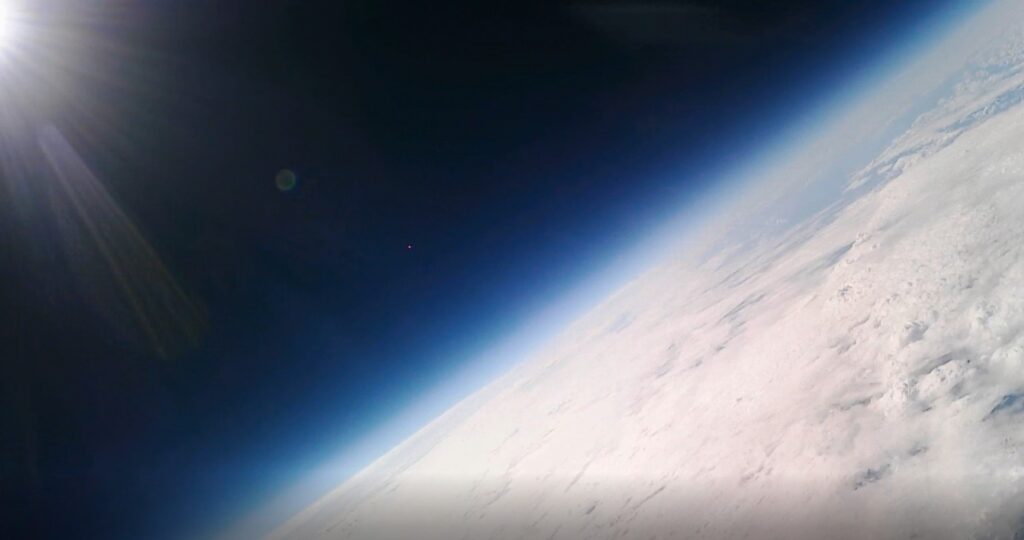
A dedicated group of girls at Croydon High School, led by Physics teacher and King’s College London alumna Arabi Karteepan, embarked on a remarkable journey to become the first UK school to launch two weather balloons to the edge of space, as part of the Astrogazers Club. The ‘Mission Aspiration’ balloons launched from the University of Bath campus reached a remarkable altitude of 32,000 metres, taking awe-inspiring images of the Earth through their payloads. The balloons themselves were named after prominent #RocketWomen, namely astrophysicist Jocelyn Bell-Burnell and the first British astronaut Helen Sharman. They contained cameras, GPS trackers and experiments to gather data for the students to investigate post-flight, including how materials responded to the varied atmospheric conditions.
Now the Astrogazers club, including pupils from the ages of 10 to 16 years old, are aiming even higher with plans to launch a satellite to space as part of ‘Mission Pegasus’. Inspirational Educator Arabi Karteepan, creator of the Astrogazers Club, has recently been awarded the Royal Astronomical Society’s 2024 Secondary and Further Education Award for her incredible work in promoting Astronomy and Space Science at the school and in the wider community.
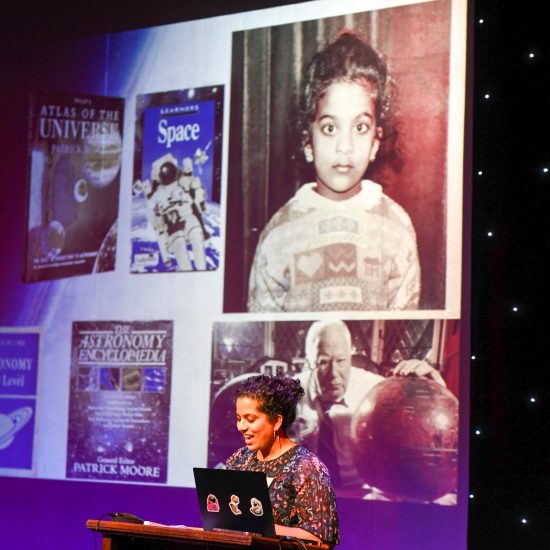
Rocket Women were thrilled to speak to Astrogazers creator Arabi Karteepan about Mission Aspiration and how she was inspired to create the Astrogazers Club!
What was the path to get to where you are now? How were you inspired to study Physics at King’s College London and what drives your passion for STEM education?
I developed a love for the cosmos from a very early age and dreamt of becoming either an astronaut or an astronomer. I would avidly re-read and flip through Astronomy and Space textbooks at home and in the library. Choosing A-level Physics, I thoroughly enjoyed studying the Astrophysics module. Being equally passionate about Mathematics and Astrophysics, I decided to pursue a joint honours degree at King’s College London in Maths and Physics with Astrophysics.
Coming from a family of teachers, I was deeply influenced by my mother’s commitment to community service through education. During my school years, I intentionally sought work experience in educational settings. In my final year at university, I opted to take the undergraduate ambassador scheme, gaining experience of teaching Physics at an independent school. This solidified my decision to pursue a career in teaching. After completing my PGCE at King’s, I entered the world of teaching.
My parents’ generation discouraged women pursuing Physics and Engineering, and my mother was unable to pursue Physics at university due to the cultural expectations, despite her love for the subject. I was grateful that my parents supported my degree choice, which is why I strongly believe that everyone should have equal opportunities, regardless of their background. I am eager to play my part in encouraging more girls to pursue STEM education.
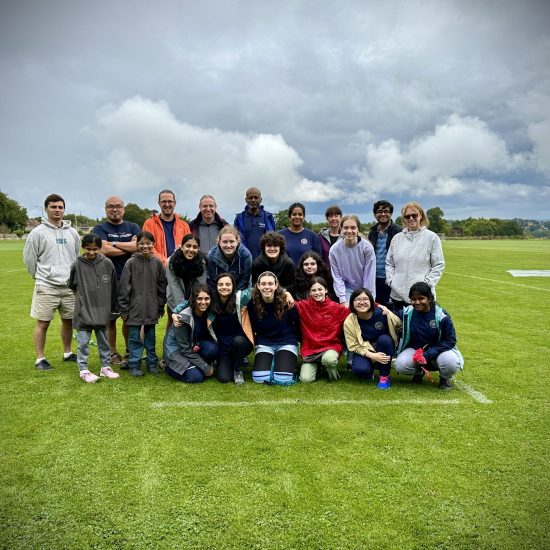
How were you inspired to create Astrogazers and can you tell me more about the remarkable high altitude balloon launch?
When I joined Croydon High School for girls in 2021, I immediately recognised how special the school community was and the incredible potential that the girls had. I could envision their ability to turn the impossible into the possible.
I wanted to offer a club that combined both my childhood passion for the cosmos and physics education. I contributed to its extensive co-curricular programme by forming and founding a STEM club called Astrogazers. The aim of Astrogazers is to promote physics, astrophysics, astronomy, engineering, and STEM-related careers.
It was great to discover that many pupils were interested in Space science. Initially I was organising activities about eclipses and constellation projectors in my club. Months later, a very small question was posed, “Could we go to space?” with my response being, “Yes, why not?”. This conversation sparked the idea of launching a weather balloon to touch the edge of space. I truly believe that if you set your mind to achieve something, it can be done. I was also determined to show the pupils that if they dreamt of doing something significant, they could definitely achieve it!
The journey from start to end was filled with numerous challenges and excitement.
Initially I was organising activities about eclipses and constellation projectors in my club. Months later, a very small question was posed, “Could we go to space?” with my response being, “Yes, why not?”. This conversation sparked the idea of launching a weather balloon to touch the edge of space. I truly believe that if you set your mind to achieve something, it can be done. I was also determined to show the pupils that if they dreamt of doing something significant, they could definitely achieve it!
What were the biggest challenges that you faced in developing the weather balloon projects and how were you able to overcome them?
Since the start of the mission in 2022, we faced multiple challenges that could potentially have ended our mission, but we persevered and overcame all the hurdles.
Quite early on, we encountered several challenges.
- Finding and securing potential launch sites was tricky because we wanted to avoid our payload passing over restricted air space and landing in the sea or in Europe! Additionally, choosing the optimal month, day, and time of day for the launch posed a huge challenge as the predicted flight path depended heavily on wind speed and direction.
- To ensure our payload landed on UK land, we spent up to 11 months tracking weather and potential flight paths to make decisions on launch day and times. We collected a wealth of data which allowed us to analyse and find patterns to conclude where and when it would be best to launch.
- Public liability insurance was a significant hurdle. Realising that we needed to partner with a university to cover the launch through their insurance led to us reaching out to many universities, only to face rejections. After changing our approach tactics, we successfully partnered with University of Bath. We are forever grateful for Professor Cathryn Mitchell agreeing to our launch proposal!
- Sourcing Helium was proving difficult due to global helium shortage, but having partnered with University of Bath, they were able to provide this.
- GPS functionality was slightly unreliable. We tested the GPS trackers by walking near buildings and trees to see if we could detect our payload if it had landed near obstructions. We decided to have two GPS trackers to maximise our chances of finding our payload.
- Getting approval from the Civil Aviation Authority to launch was difficult, as we only received the approval roughly 14 hours before the proposed launch window. We carried on as planned, having the minibus and equipment ready for departure at 5:00am. Confirmation of travel to Bath wasn’t communicated to the school, pupils, and parents until the evening before launch day. Preparation and organisation were key to making launch day as smooth as possible to minimise the issues arising from the CAA’s late notice.
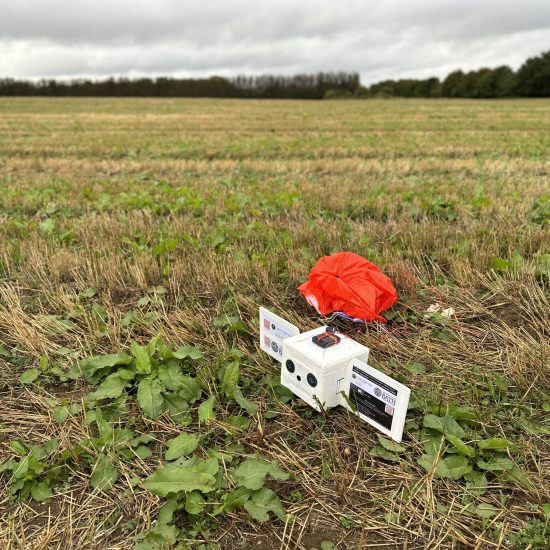
The first launch took place in June 2023. Due to strong wind gusts, the parachute cord detached from the weather balloon due to a friction burn from the release cord. We had the biggest learning curve on this day and realised that we are ultimately at the mercy of the elements. We saw discrepancies between the wind speeds on the weather forecast and the anemometer readings. We used this opportunity to reflect on the unsuccessful launch to identify what to do better next time.
- We decided to launch two medium sized weather balloons instead of the large one we initially used. This meant that our payload mass was reduced. It was a challenge to fit our payload items in two payload boxes with mass restrictions imposed, so we measured every centimetre of tape we used to build our payload and measured every gram of every item on the payload. We made the decision to use paper to print the logos and QR codes as opposed to using card previously, purely for the fact that laminated paper was lighter than laminated card.
- One of the pupils had knowledge about knots and what type of knots would be best to prevent the cords from unravelling and snapping. With this, we were confident that the connection points between the payload to the parachute and the parachute to the balloon were secure.
- We were unsure if the GPS tracker would turn back on again upon descent if it stopped working at high altitude due to the low temperature. We tested the GPS functionality in cold environments.
- We applied for a longer launch window from the CAA, so we had a longer timescale to work within enabling flexible decision making based on live weather data.
In early September 2023, our planned launch from University of Bath campus faced delays due to unfavourable winds from an Atlantic weather front. Despite this, we successfully launched the Bell-Burnell and Sharman payloads.
- I devised a minute-by-minute plan indicating each member’s role in the launch which was incredibly detailed and thorough compared to the previous launch. We rehearsed many times to build muscle memory, allowing team members to gain time to assist other Astrogazers with their designated tasks.
- We tracked the payloads in real-time. We encountered challenges during the Sharman payload launch, with GPS tracker failures and unexpected rain making things difficult. However, resilience and quick thinking, including activating a back-up GPS tracker, overcame these challenges.
The successful launches couldn’t have happened without encountering and enduring challenges and failures. Mission Aspiration is proof that failure does lead to success!
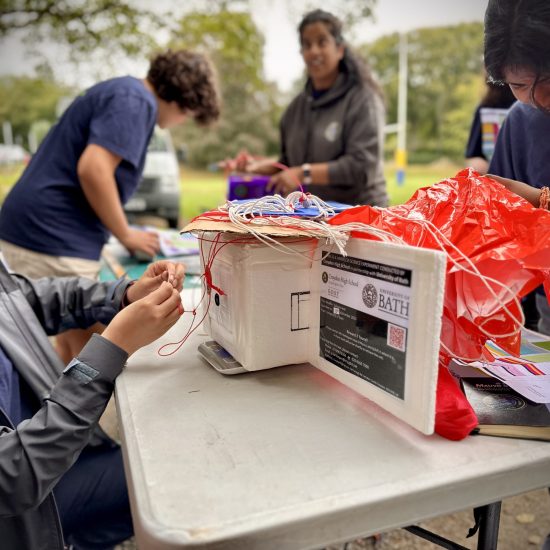
What impact do you feel that this fantastic project has had on the students involved in the weather balloon launch and development?
Mission Aspiration is a proof that with determination and dedication, you can accomplish anything! The pupils have had a real-world project experience outside of the classroom and each of them has developed and strengthened key skills. The impact of this launch has rippled across the school community and Astrogazers is now a hugely over-subscribed club with a growing waiting list of girls wanting to join.
There was an overwhelming number of girls at the Junior school (aged 4-11) who have expressed their wish to join Astrogazers since learning about the weather balloon success. As a result, we decided to expand across from the Senior school to the Junior school to form a ‘Junior Astrogazers’ club. The whole school and wider community will be involved in Mission Pegasus.
Hear from few of the pupils involved in Astrogazers:
“Astrogazers has not just done a lot for me personally but has affected the girls throughout the school. I have massively grown in confidence as I helped to lead my peers in the Weather Balloon launch; all the girls in the club have developed teamwork capabilities and have grown personally as they realise their abilities to achieve incredible things; and the girls in the wider school community, all the way down to the youngest girls in the Junior School, have been impacted by Astrogazers too. Astrogazers has shown them the capabilities of Women in STEM, and that if you believe in your own abilities and work as a team, then incredible things can be achieved. I am immensely proud to say that I am part of this unique club.” Isla M, Year 12.
Astrogazers has shown them the capabilities of Women in STEM, and that if you believe in your own abilities and work as a team, then incredible things can be achieved.
“Through the growth of Astrogazers, I, together with many other girls throughout the school have been able to develop and enhance our skills, confidence and abilities. We have been able to impact and inspire students of all ages, allowing us to communicate and interact with peers who we may never have even talked to. The members of Astrogazers have grown immensely with greater abilities and achievements allowing us to realise our personal capabilities. Astrogazers is and will continue to be a stepping stone for many young girls to become Great Women in STEM, providing us with a useful skillset that will last us beyond our school years. I am grateful to be a part of such a fun, inspirational and striving community.” – Aashka P, year 12:
Hear from the parents of the pupils involved in Astrogazers:
What a fantastic achievement for the Astrogazers team and for CHS! It is truly pioneering and I have noticed it has sparked a lot of interest from the community, other schools, my family and friends, everyone has been talking about it. Hollyann has been so inspired and animated and she has learnt so much. There have been so many elements to this project – team work, planning, researching, problem solving, communicating with each other, keeping calm under pressure, gaining confidence to speak in front of the camera etc. Your enthusiasm, organisational skills, your ability to communicate, impart knowledge and listen to the team’s ideas and best of all you made it fun! You thought of everything – thank you for inviting the parents – at the first launch to stand back and watch your child be part of a well-oiled machine was just magic – everything was labelled, procedure was followed, every child had a role. The detail and the thoughtfulness, even down to the Ivy necklace travelling with the balloon was a wonderful touch. When the pupils’ first balloon dropped the payload, you took the girls off to regroup, so instead of a disappointed Hollyann returning, she came back enthused and determined with answers – what went wrong, how can we address this and looking forward to the next launch – a great life lesson which the best of scientists experience.
Thank you very much. Hollyann has gained so much and I believe it has been one of those pivotal moments in life where she has been able to use her knowledge and passion of meteorology. Pupils and parents have fond memories of Astrogazers to treasure and carry with them.
Hear from Croydon High’s pre-school:
“The Astrogazers successful weather balloon launch had a profound impact on our pre-school group, Little Ivy’s Stay and Play, triggering a ripple effect of inspiration. From crafting aeroplanes to building rockets and creating locomotives, the tots embraced the spirit of exploration and teamwork. The Astrogazers payload of positivity radiated a rainbow of ripples throughout the Croydon High community, showcasing the contagious nature of their uplifting initiative.” – Little Ivy’s Stay and Play.
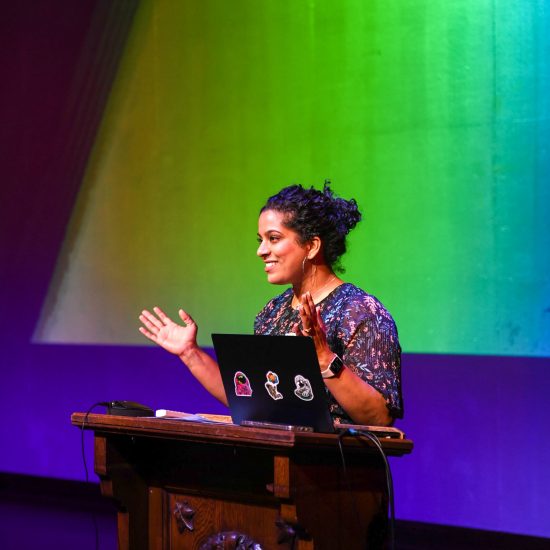
Congratulations on your well-deserved award for your outstanding work in STEM education! What is next for Astrogazers and I’d love to hear more about Mission Pegasus?
Thank you so much; it has been an honour to receive the RAS award. Astrogazers are now embarking on their next mission, Mission Pegasus. As part of this mission, we will be building our satellite payload to go into space! We have a scientific aim behind our mission, which we will share with our followers on YouTube and Instagram very soon! You can follow us on YouTube and Instagram to get all the updates on Mission Pegasus.
Astrogazers has expanded in size with the addition of the Junior Astrogazers. The team working on Mission Pegasus includes pupils from the Junior and Senior school, Croydon High’s alumna Hannah Schmitz (Principal Strategy Engineer at Red Bull), Matthew White (IT Flywheel Services), and Prof Cathryn Mitchell and Dr Robert Watson from University of Bath. We are working together to make this mission become a reality!
To follow Astrogazers’ remarkable story, take a look at their social media pages:
https://www.youtube.com/@Astrogazers
https://www.instagram.com/_astrogazers_/
